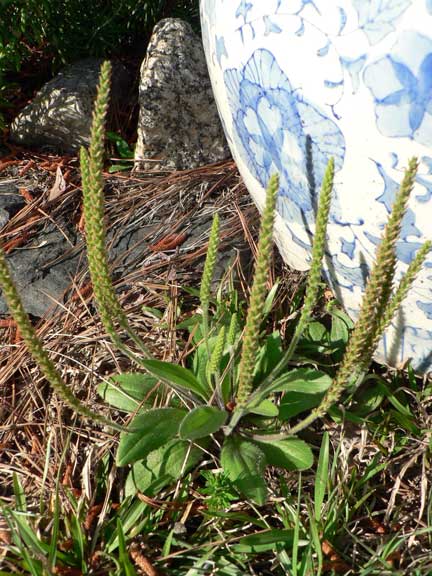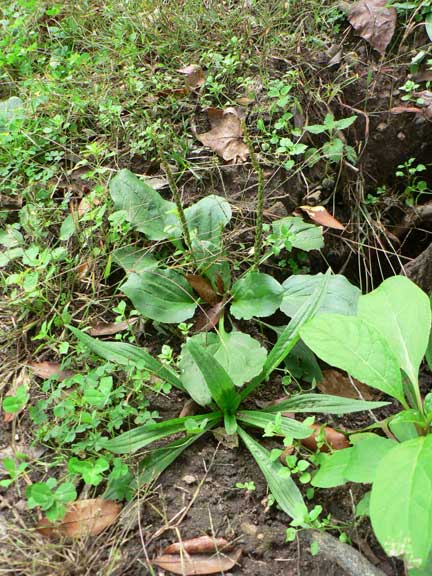.jpg)
Plantain herb is the first local plant that I learned to use, and this awesome herb is what got me started studying and using natural remedies. It’s really an amazing little plant. Today, I’m going to show you some tricks to identifying plantain.
My next post will go into a lot more detail about its uses and how to use it in home remedies.
The photo above shows one of the common varieties of plantain as you may find it in your yard or in any area that is regularly mowed. This is a little small cluster of plantain leaves. The leaves grow in what’s called a ‘basal rosette.’ The leaves will lay almost flat in a lawn, but plantain herb can also grow in a more upright habit like this.
.jpg)
Both varieties I’ve shown you so far are called narrowleaf plantain or ‘plantago lanceolata’. They are just one of the over 200 varieties of plantain that grow all over the world. They are very hardy herbs, and can grow in any sunny spot, even in poor soil. As you can see here, these plants have anchored themselves in bare red clay on a slope.
Plantain has been used as a medicinal herb and food since ancient times. It was considered to be a ‘cure all’ or panacea herb by many cultures. Today, it’s really worth it to learn to identify the varieties of plantain growing in your area, as it is very useful as a bee sting remedy and a poison ivy cure.
It’s fairly easy to identify narrowleaf plantain this time of year, as it has a very distinct seed head or flower.
.jpg)
We used to shoot them at each other when we were kids like this:
.jpg)
There is a nice steep hillside near our house that hardly ever gets mowed, and it is coverd in plantain. These are the types of places that you’d want to gather lots to dry and use throughout the year.
.jpg)
But wait…there’s more! Here are two other forms of plantain that grow in my area. This is common plantain (‘plantago major L.’)

and virginia plantain (‘plantago virginica L.)

These last two varieties look vastly different than the narrowleaf plantain. Even the seed heads are way different than the first photos that I showed you. But here’s the trick to id’ing plantain…they all contain one key feature that will help you identify them as a true plantago: vertical leaf veins.
Plantains all have strong vertical veins that run the length of the leaf. Here is a look at the tops and bottoms of a large plantain leaf. See those nice strong veins that run from the tip to the stem?
.jpg)
.jpg)
Are you ready for the pop quiz? Can you find the plantain in this photo? I’ll reveal the answer in the next post on plantain use.

Now that you’ve seen the species in my back yard, take a few minutes to look up the kinds growing in your neck of the woods. You can look up the varieties of plantain in your area with these U.S. distribution maps.
Just back from Lake Balaton in Hungray. A couple we stayed with use Plantain in a tincture for chest remedies
Very cool! Thank you for sharing! Is this like for a chest cold?
VERY helpful for beginners such as myself. Thanks!
Thank you for the informative and enjoyable article .
Hello, thank you for the article. I have some beautiful large plants in my yard that I believe are plantain. I live in MT. If I send a photo, might you be able to help me know for sure if they are? I have tried to research on my own and they look somewhat similar to the plantain photos I find but not exact.
Thx much
Kim
Hi, is the. Plantain virginia species used medicinally just like the lanceolata? Thanks.
I gathered some of this in Oklahoma. It looks and grows like the broadleaf variety described but has a very light green back on the leaves that is tough and will actually peel. Do you think it is still plantain?
One of the better articles I have seen on Plantain. Most have awful or unrealistic pictures without a real scale. We have some pretty tiny version of it growing here at a park, and I was worried about a positive ID. particularly like the vertical vein detail and the “can you identify it in this picture” because you got a somewhat tricky shot!
Thank you, Richard!
Broadleaf plaintain was the bane of my backyard several years ago. I had no idea what it was and was unsuccessful trying to identify it online. One summer I made it my mission to rid my backyard of what I had dubbed “lawn cabbage”. I crawled around on my hands and knee digging up garage bags full of the stuff.
My husband and I live on an acre, in Alaska, most of which is comprised of our backyard.
A few years later I finally found out what this plant was called and that it was edible (I never did rid our backyard of it). Recently I decided to boil some leaves up and eat them after seeing Nicole – on season 2 of Alone – eat some. They were good. My husband and I are currently watching season 3 of Alone and a contestant named Callie used narrowleaf plaintain to create a poltice to treat some infected spider bites she received. I wasn’t aware of any other varieties of plaintain and decided to look up the type Callie harvested. That’s how I came across your article. I certainly wasn’t expecting to find out that there are over 200 varieties!
I love hearing how you came about learning about plantain! How did you boil it? Did you change the water out to help with bitterness? I’m in the south, and many of the greens that grow here get very bitter in the heat. Maybe Alaska doesn’t have that same challenge. 😉
thank you I have a lot of this plant in my yard. I am going to get it and dry it use it as tea. Thany verymuch for this information.
I don’t care for the flavor of it, but I still find it to be a very useful herb. We use it on stings, bites, scrapes, etc. I’ve heard of people cooking the greens like spinach. I live in hot climate, so my plantain and dandelions are very bitter. I would probably have to change the water a couple times to get it to be edible as greens. 😉
I remember growing up in West Virginia. On the farms In the farm yards where we would visit There was one my mother and her first cousin would call red vein plantain. I remember that the red juice could be squeezed on a wasp sting and the pain would go away instantly. However, it has been over forty years since I have seen any. I heard that it was one of the first herbs totally eliminated by herbicides. Is any of this true to your knowledge?
I’ve never heard of this variety. I know the native plantago rugelli has red tips to the stems. I’ll have to check to see if the juices run red. 🙂 Good story! Thanks for sharing!
I love this plant
Me. Too. 🙂